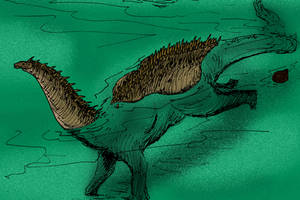Deviation Actions
Description
When people want to feature the fauna of Early Cretaceous Brazil, they usually pick the Santana Formation as their setting because of its spinosaurids and pterosaurs. However, the Crato Member of the Santana Formation has been reclassified as its own formation with a separate age, meaning that anyone who wants to stay true to the Santana Formation must exclude the most notable pterosaur, Tupandactylus imperator. Meanwhile the only dinosaur remains from the Crato Formation are few indeterminate teeth, so most people don’t bother wit it. But having brackish sediments, the Crato Formation actually has a lot of well-preserved insects, some of which really deserve to be more well-known.
Parababinskaia elegans: A neuropteran with 12 mm long forewings that sits at the base of the food chain. Traced over this photograph of the fossil: 1.bp.blogspot.com/-RJ79sOViPpg…
Santanmantis axelrodi: A 12.5 mm long dictyopteran of the order Mantodea. This early praying mantis has raptorial forelimbs to catch smaller insects. Traced over this reconstruction: assets.atlasobscura.com/articl…
Raptoblatta waddingtonae: A 21.7 mm long dictyopteran. While it has raptorial forelimbs, it is not a mantodean and may be more closely related to cockroaches. It feeds on smaller insects, including its predatory relative Santanmantis. Traced over a reconstruction from the following paper:
Dittmann I-L., Hörnig M-L., Haug J-T. & Haug C. 2015: Raptoblatta waddingtonae n. gen. et n. sp. — a roach-like insect from the Lower Cretaceous with a mantodean-type raptorial foreleg. Paleodiversity 8, 103–111.
Makarkinia adamsi: A giant neuropteran of the family Kalligrammatidae with 16 cm long wings. Kalligrammatids filled the ecological role of modern butterflies. The eyespots on their wings may be used to confuse predators. Traced over this reconstruction of Kalligramma: lenta-vremeni.ru/img/614/_051.…
Mickoleitia longimanus: The only member of the new insect order Coxoplectoptera, which are also called “chimera wings” because they have the raptorial forelimbs of a praying mantis, the thorax and hind wing form of a dragonfly and the wing venation of a mayfly. Both the 32 mm long aquatic larvae and the 40 mm long flying adults prey on anything they want. Traced over the photographs of the fossils on Wikipedia.
Cratoavis cearensis: The only Enantiornithine known from Early Cretaceous South America. This bird feeds on small insects and has long tail feathers for display. Drawn based on this reconstruction: ornitofrenia.pl/wp-content/upl…
Tetrapodophis amplectus: A 1 m long basal snake or near-snake that still has four limbs. It swims through the brackish water to catch small animals. Traced over this reconstruction: cdn.iflscience.com/images/c9a1…
Cladocyclus gardneri: A 1.2 m long ichthyodectid fish. Depending on its ontogenetic stage, this ravenous fish feeds on insects, birds, snakes or even juvenile pterosaurs. Traced over this photograph of the fossil: cdn6.bigcommerce.com/s-fme25/p…
Ludodactylus sibbicki: An ornithocheiroid pterosaur representing all the various toothed fish-eating pterosaurs of the Cretaceous. Drawn based on the reconstruction on Wikipedia.
Tupandactylus imperator: An omnivorous tapejarid pterosaur with a ridiculously large head crest. The only animal from the Crato Formation most people seem to know. Drawn based on the reconstruction on Wikipedia.
Pretty cool

































